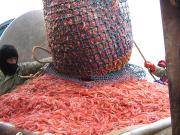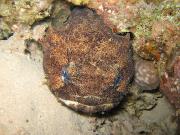Radio Program
Our regular Science and the SeaTM radio program presents marine science topics in an engaging two-minute story format. Our script writers gather ideas for the radio program from the University of Texas Marine Science Institute's researchers and from our very popular college class, Introduction to Oceanography, which we teach to hundreds of non-science majors at The University of Texas at Austin every year. Our radio programs are distributed at to commercial and public radio stations across the country.
Tropical cyclones are a fact of life on the islands of southeast Asia. Among other things, they can damage reef systems that attract divers and other tourists, harming local economies. How people and institutions handle that challenge can determine how quickly they recover.
This idea is known as adaptive capacity. It’s the ability to absorb shocks, recover and learn from them, and apply those lessons to make things better.
The pistol shrimp has terrible eyesight. But some species of the shrimp get help -- not spectacles, but a companion fish: a goby. It keeps an eye out for predators. In turn, the shrimp maintains a burrow that’s used by both of them.
The pistol shrimp gets its name from one of its claws, which is larger than the other. It snaps the claw shut quickly, generating bubbles. When the bubbles collapse, they produce a loud sound -- like a gunshot. That can stun prey, and allow the shrimp to communicate with other shrimp around it.
Bodega Bay is best known for its birds. Not real birds, but the scary ones from a movie: Alfred Hitchcock’s “The Birds.” The film was set and shot in the village of Bodega Bay, California, up the coast from San Francisco.
We might not always think so, but people who spend time preening in a mirror are actually passing an intelligence test -- showing an awareness that the thing in the mirror is them. Only a few other species have shown this level of self-awareness, including dolphins and elephants. The most recent addition to the list is a fish that was already known to be pretty smart.
A calm day on the beaches of the Pacific Northwest can turn deadly in a hurry. A single large wave can rush ashore, running inland up to 50 yards farther than the previous waves. Anyone who’s too close can be washed into the ocean. In fact, more than two dozen beachgoers have been killed by such waves in the last decade and a half.
An ancestor of modern-day whales may have paddled across the Atlantic Ocean like an otter. And when it reached the Americas, it could have walked out on its back legs.
Scientists discovered the fossilized skeleton of this odd creature in the desert of Peru, near the Pacific Ocean. It was in layers of sediment that were almost 43 million years old. That makes it the oldest creature of its kind found in the southern hemisphere or in the Pacific Ocean.
Like its garden-variety namesake, the sea cucumber doesn’t get around much. Most species appear to spend their entire adult lives on the same patch of sea floor. But recent research suggests that at least some of them may get out more. They’ve been seen to drift along like tumbleweeds.
Sea cucumbers are named for their resemblance to the vegetable. They have long, tube-shaped bodies with a mouth at one end. Tentacles around the mouth allow them to scoop up mud and sand, which they filter for food.
We Americans love our shrimp, salmon, and canned tuna -- we eat more of those than any other type of seafood. Overall, in 2017 we consumed about 16 pounds of fish and shellfish per person -- just below the all-time high.
Fishing just isn’t what it used to be -- commercial fishing, that is. For much of the last century, the world’s fleets brought in more fish and shellfish every decade. Since about 1990, though, the catch has remained about the same. And one recent study logged a four percent decline in the productivity of the world’s main fisheries between 1930 and 2010.
It’s probably not surprising that a critter known as a toadfish can be a bit rude. A couple of studies in recent years have found that male toadfish “grunt” when their neighbors are trying to court females. That makes a neighbor’s call a bit less attractive -- perhaps giving the grunter an advantage in finding a mate.
The studies targeted a species of toadfish along the Atlantic coast of Central and South America. It lives in shallow coastal waters, in areas with rocky or sandy bottoms.











